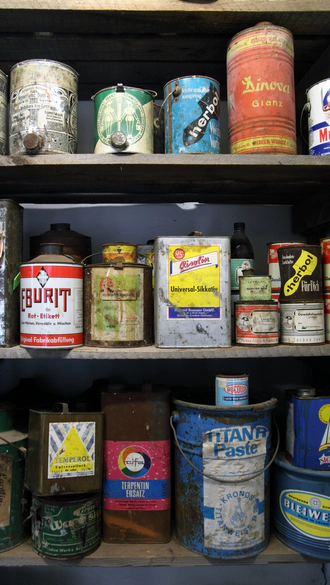Inhalants Commonly Abused in Growing Trend
Common household items can be abused to deadly effect. Fumes from chemicals easily found in most homes can be concentrated and inhaled.

Defining Inhalants and Huffing
Inhalants refer to a broad range of household and industrial chemicals whose volatile vapors or pressurized gases cause a mind-altering effect when breathed through the nose or mouth. Such vapors produce intoxication in a manner not intended by the manufacturer. In fact, many of these substances are actually poisonous to inhale, and they carry warning labels that specifically caution people not to inhale them.
The term ‘huffing’ refers to the act of breathing in the vapors of such chemicals. A partial list of substances that can be huffed includes:

- Certain types of glue
- Spray paint (stored in aerosol cans)
- Gasoline
- Propane
- Butane
- Lighter fluid
- Whipped cream dispensers
- Hair spray (stored in aerosol cans)
- Nail polish remover
- Paint thinners/removers
- Felt-tip markers
- Computer cleaner sprays
- Fabric protector sprays
- “Poppers” (a liquid concentration of amyl nitrate)
- Deodorant sprays
- Vegetable cooking sprays
The sinister nature of inhalants (and why young people tend to be the demographic that experiments with such drugs) is that inhalant substances are so readily available. Most homes have many of the above substances stored in the kitchen, bathroom, garage, laundry room, or utility closet.
The Scope of Inhalant Abuse in the U.S.
While inhalants don’t register very high on the list of popular drugs of choice, millions of Americans still experiment with inhalants every year. The National Institute on Drug Abuse reports that about 0.9% of Americans over 12 (2.4 million people) use inhalants at least once per year. Approximately 215,000 Americans are addicted to experimenting with inhalants.1
Beyond the overall scope of inhalant use, it’s also important to examine the individual demographics who use inhalants. According to NIDA data and the Substance Abuse and Mental Health Services Administration (SAMHSA), adolescents and teenagers are at particular risk of experimenting with inhalants and being seriously harmed by them. Approximately 4.8% of 8th graders, 2% of 10th graders, and 1.8% of 12th graders use inhalants. Shockingly, this means eighth-graders are five times more likely to use inhalants than adults are, while 10th and 12th graders are twice as likely to use such drugs.2

In addition to inhalants being more commonly used by children and teenagers than adults (a factor that is quite unique to this drug type), inhalants are also more likely to be used by girls than boys. According to the data, 3.2% of girls ages 12 to 17 use inhalants, compared to 2.3% of boys in this same age group.
Finally, young people who use inhalants often use them more than once. SAMHSA reports suggest that 59% of people who use inhalants use them between one and 11 times per year. About 19% use the substances between 12 to 49 times per year, 14% use them 50 to 99 times per year, and 7% use such drugs 100 to 299 times per year. Given that any instance of inhalant experimentation could be fatal, these usage trends are extremely concerning.
Shifting Trends in Inhalant Experimentation and Predictions for the Future
The SAMHSA report cited above was published in 2015. In that report, the researchers indicated that 3.4% of high school freshman-age youths use inhalants, and 1.7% of high school senior-age youths use such drugs. Compare that 2015 data to NIDA’s report (also cited above), which found that 4.8% of 8th graders use inhalants and 1.8% of 12th graders use these substances. Given that the NIDA report was updated in 2021 and showcases a higher rate of use among youths than the 2015 SAMHSA report does, it would seem that inhalant abuse is on the rise among youths.
If inhalant experimentation continues on its present course, adolescents and teenagers will be at even greater risk in the coming years.
Death Statistics, Inhalant Usage Trends Lead to Extreme Risk Factors for Users
Thanks to a growing body of qualified research into the effects of inhalants on young people, it’s becoming clear just how dangerous the act of huffing (or ‘chroming’ as it is sometimes referred to) is. There is irrefutable evidence that young people can die from inhalants, even if they use them just once. Based on further NIDA research, the increasing popularity of inhalant experimentation, particularly among young teens, has led to approximately 100 to 200 deaths each year.3
Toxicology investigation of inhalant-related deaths has led experts to believe that the extremely concentrated chemicals in various solvents and aerosol sprays can induce irregular, rapid heart rhythms, potentially leading to fatal heart failure within minutes. Inhalants have also been found to cause death by asphyxiation, suffocation, convulsions, seizures, coma, choking, and fatal injury.
A Warning to Parents
Given the extreme risks to users when they huff the fumes or vapors of many household products, every parent needs to understand the statistics and usage trends surrounding inhalants. And given that inhalant usage seems to be increasing among young people in or near the eighth grade, parents must educate their kids at a very early age about the harmful nature of such substances.
Sources:
-
NIDA. “What is the scope of inhalant use in the United States?” NIDA, 2021. nida.nih.gov ↩︎
-
SAMHSA. “Understanding Adolescent Inhalant Use.” SAMHSA, 2015. samhsa.gov ↩︎
-
NIDA. “What are the other medical consequences of inhalant abuse?” NIDA, 2021. nida.nih.gov ↩︎






 ®
®